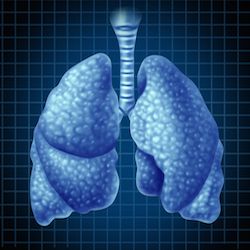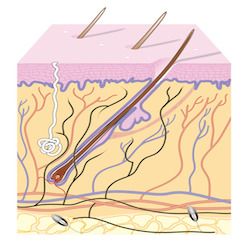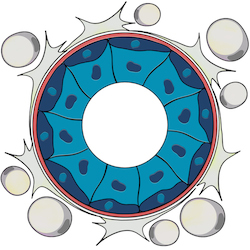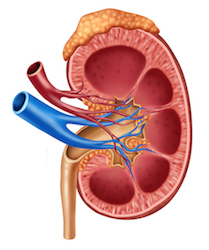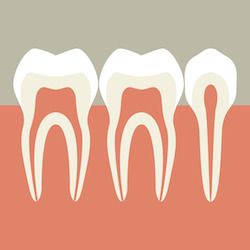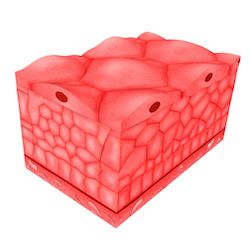Human Epithelial Cells
Human airway epithelial cells
Airway epithelial cells represent a critical barrier that defends the airways against the environment and form apical-junctional complexes that are key to maintaining barrier
function. Each area has a different composition of cell types to perform distinct functions thereby maintaining the integrity of the epithelium and lung function. Airway epithelium
typically has a low, yet constant, turnover rate in which cells damaged by the environment are replaced. Although composed of the same major cell types, ciliated, undifferentiated
columnar, secretory, and basal cells, the large airway epithelium is pseudostratified whereas the small airway epithelium is simpler and columnar. Airway epithelial cells play an
essential role in the innate immune system via the production of antimicrobial substances, secretion of chemokines and cytokines and the promotion of mycociliary clearance.
Dysfunctional airway epithelium is linked to many respiratory disases including chronic obstructive pulmonary disease (COPD) and asthma. Primary and low passage airway cells
therefore have many applications including as in vitro disease models or for immunology, inhalation and air/liquid interface studies.
Axol human
airway epithelial cells are derived from resected tissue that has been isolated from different regions of the lung as follows:
- Bronchial/Tracheal Airway Epithelial Cells isolated from the trachea or upper bronchial region of the lungs.
- Large Airway Epithelial Cells isolated from the lobar (secondary) bronchus.
- Small Airway Epithelial Cells isolated from the small airways (less than 2 mm) of the lungs.
| Cat. No. | Product Name | Quantity |
|---|---|---|
| ax3515 | Bronchial/Tracheal Airway Epithelial Cells | 500,000 cells |
| ax3001 | Large Airway Epithelial Cells | 500,000 cells |
| ax3002 | Small Airway Epithelial Cells | 500,000 cells |
| ax0035 | Airway Epithelial Cell Culture Medium | 500 mL |
Human lung epithelial stem cells
Lung Epithelial Stem Cells from purified Lgr6+ E-Cadherin+ cells isolated from dissociated primary
lung tissue. The lung epithelial stem cells express lung specific markers (SP-C, CC-10, AQ5), epithelial markers (E-CAD), and stem cell markers
(SOX9, LGR5/6, Integrin-alpha 6). The lung stem cells have self-renewal capacity and can be repeatedly passaged in suspension culture using Axol
Lung Epithelial Stem Cell Culture Medium. The stem
cells can be differentiated to alveolar and bronchiolar cell types in vitro and in vivo. The lung stem cells are cultured adherently
for in vitro differentiation and the culture vessel ECM coating influences lineage differentiation of the stem cells.
Click on the product below to see the data, further information and the protocol.
| Cat. No. | Product Name | Quantity |
|---|---|---|
| ax3005 | Lung Epithelial Stem Cells | 500,000 cells |
| ax3580 | Lung Epithelial Stem Cell Culture Medium | 500 mL |
| ax0044 | Unlock | 25 mL |
| ax0041 | SureBond Coating Solution | 3 x 120 μL vials |
| ax0049 | Fibronectin Coating Solution | 1 mL |
| ax0047 | Recombinant Human FGF2 | 100 μg |
| ax0047X/ax0048 | Recombinant Human EGF | 100 μg |
Human keratinocytes and melanocytes
Our epidermal keratinocytes are available as a pooled lot from several donors or as cells from individual donors. If you have specific donor requirements, please inquire and we will endeavour to help. The keratinocytes are cultured in our serum-free Keratinocyte Cell Culture Medium and are cryopreserved at passage 1 or 2. Our keratinocytes can be passaged more than 5 times in our culture medium and maintain a normal cell appearance.
Melanocytes are dendritic cells located between the epidermis and dermis of human skin. Melanocytes produce melanin, contributing to the pigmentation of the skin. Our melanocytes are derived from skin tissue from juvenile or adult donors. They can be passaged more than 4 times when grown in our low-serum (1%) Melanocyte Growth Medium (ax3531). Melanin production is significantly increased when the melanocytes are switched into our fully-defined, serum-free Melanocyte Differentiation Medium (ax3532). Our Melanocyte Assay Medium (ax3542) is a growth factor-reduced medium that increases the responsiveness of melanocytes to experimental stimuli.
| Cat. No. | Product Name | Quantity |
|---|---|---|
| ax3525 | Keratinocytes (Pooled Donors) | 500,000 cells |
| ax3526 | Keratinocytes (Single Donor, Juvenile) | 500,000 cells |
| ax3527 | Keratinocytes (Single Donor, Adult) | 500,000 cells |
| ax3528 | Keratinocyte Cell Culture Medium | 500 mL |
| ax3560 | Keratinocyte 3D Culture Medium | 500 mL |
| ax3570 | Keratinocyte 3D Culture Starter Kit | 1 kit |
| ax3529 | Melanocytes (Single Donor, Juvenile) | 500,000 cells |
| ax3530 | Melanocytes (Single Donor, Adult) | 500,000 cells |
| ax3531 | Melanocyte Growth Medium | 500 mL |
| ax3532 | Melanocyte Differentiation Medium | 250 mL |
| ax3542 | Melanocyte Assay Medium | 250 mL |
Human mammary epithelial cells
The normal human mammary gland epithelium is comprised of cells from two lineages: basal and luminal. Basal cells, also known as myoepithelial cells, are smooth muscle-like cells that contract in response to oxytocin, an essential process in lactation. Luminal cells are responsible for milk secretion into the lumen of the mammary gland. Basal and luminal cells can be purified from our mammary epithelial cells on the basis of their surface markers using flow cytometry.
Our mammary epithelial cells are a mixed population of basal (CK14+) and luminal (CK18+) epithelial cells. Many immortalised HMEC lines consist of only basal/myoepithelial cells and so do not provide good models for the study of luminal cell biology or development of luminal subtype breast cancer. Our mammary epithelial cells are cryopreserved at passage 3 and can be passaged more than 4 times in our mammary epithelial cell culture medium.
 Human mammary epithelial cells in 2D culture.
Human mammary epithelial cells in 2D culture.Basal cells are marked by the expression of cytokeratin 5 (green) and luminal cells are marked by the expression of cytokeratin 18 (red). The cells were counterstained with DAPI (blue).
| Cat. No. | Product Name | Quantity |
|---|---|---|
| ax3512 | Mammary Epithelial Cells - Male | 500,000 cells |
| ax3513 | Mammary Epithelial Cells - Female | 500,000 cells |
| ax3537 | Mammary Epithelial Cell Culture Medium | 500 mL |
Human renal and bladder epithelial cells
Our renal epithelial cell medium is a low-serum (0.5% FBS) media and does not contain phenol red or antimicrobials thereby reducing cell stress and promoting viability for healthy cultures. The cells are isolated from single donors and then expanded once or twice in culture before being cryopreserved. Our renal epithelial cells and optimized media used in combination are ideal for the study of renal function, metabolism, nephrotoxicity or renal cancer research. The renal epithelial cells can be passaged more than 4 times in Axol Renal Epithelial Cell Culture Medium.
The bladder is lined with a transitional epithelium, also referred to as urothelium, which forms a protective barrier between urine and its solutes and the underlying bladder. A key part of maintaining the barrier function of bladder epithelial cells is the formation and maintenance of surface mucus. The urothelium is a key protective surface that when disrupted can lead to interstitial cystitis. Moreover, over 90% of bladder cancers derive from these epithelial cells - termed 'transitional cell carcinomas". Primary/low passage bladder epithelial cells represent a valuable resource for experiments investigating bladder cancer, interstitial cystitis and many other applications.
Human corneal epithelial cells
The maintenance and integrity of the corneal epithelium is dependent on limbal stem cells and is an essential barrier to ensure ocular functions are not disrupted. We isolate cells from human corneal tissue, expand them in culture vessels and then cryopreserve the corneal epithelial cells. The corneal epithelial cells are then provided to you at low passage, ready for your experiments. Our corneal epithelial cells and serum-free culture media are ideal for numerous applications, including ocular function studies, cytotoxicity testing, inflammation research and drug screening.
| Cat. No. | Product Name | Quantity |
|---|---|---|
| ax3502 | Corneal Epithelial Cells | 500,000 cells |
| ax3533 | Corneal Epithelial Cell Culture Medium | 500 mL |
Human gingival epithelial cells
Epithelial cells isolated from human oral gingiva tissue from a single adult donor. The cells are expanded in our fully-defined, serum-free Gingival Epithelial Cell Culture Medium and are cryopreserved at passage 2. The gingival epithelial cells can be passaged more than 4 times in Axol Gingival Epithelial Cell Culture Medium
| Cat. No. | Product Name | Quantity |
|---|---|---|
| ax3555 | Gingival Epithelial Cells | 500,000 cells |
| ax3556 | Gingival Epithelial Cell Culture Medium | 500 mL |
Human prostate epithelial cells
The function of the prostate is dependent on interactions between the epithelium and underlying stroma. The two best characterized prostate epithelial cell types are basal and luminal, which can be distinguised based on cytokeratin expression. The basal cells typically express cytokeratin 5 and cytokeratin 14 while the luminal cells express cytokeratin 8 and cytokeratin 18. Our normal prostate epithelial cells have been harvested from prostate tissue and then expanded twice prior to cryopreservation. We provide a serum-free prostate epithelial cell culture medium that does not contain phenol red or antimicrobials therefore minimizing cellular stress and promoting healthier cultures. This provides a culture system for use in numerous applications including studies into prostate function and prostate cancer.
| Cat. No. | Product Name | Quantity |
|---|---|---|
| ax3507 | Prostate Epithelial Cells | 500,000 cells |
| ax3541 | Prostate Epithelial Cell Culture Medium | 500 mL |
Human colon epithelial cells
| Cat. No. | Product Name | Quantity |
|---|---|---|
| ax3368943 | Epithelial Colon Cells - Transverse Colon | 500,000 cells |
| ax3368942 | Epithelial Colon Cells - Duodenum | 500,000 cells |
| ax3368941 | Epithelial Colon Cells - Descending Colon | 500,000 cells |
| ax336894 | Epithelial Colon Cells - Ascending Colon | 500,000 cells |
| ax336897 | Intestine Cell Media | 100mL |
Custom cell & tissue sourcing
from healthy and patient donors. Simply tell us your specifications and we will endeavour to meet your requirements.
Custom cell sourcing
